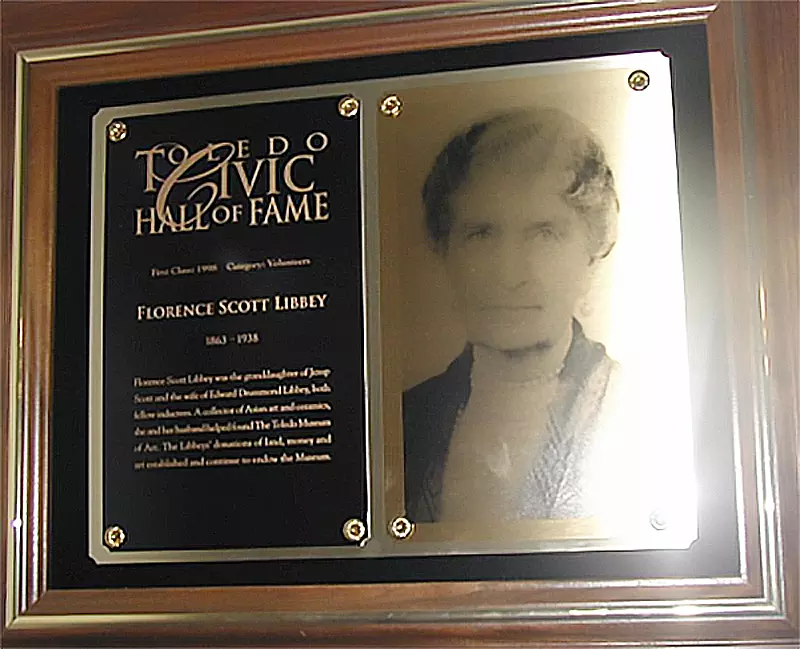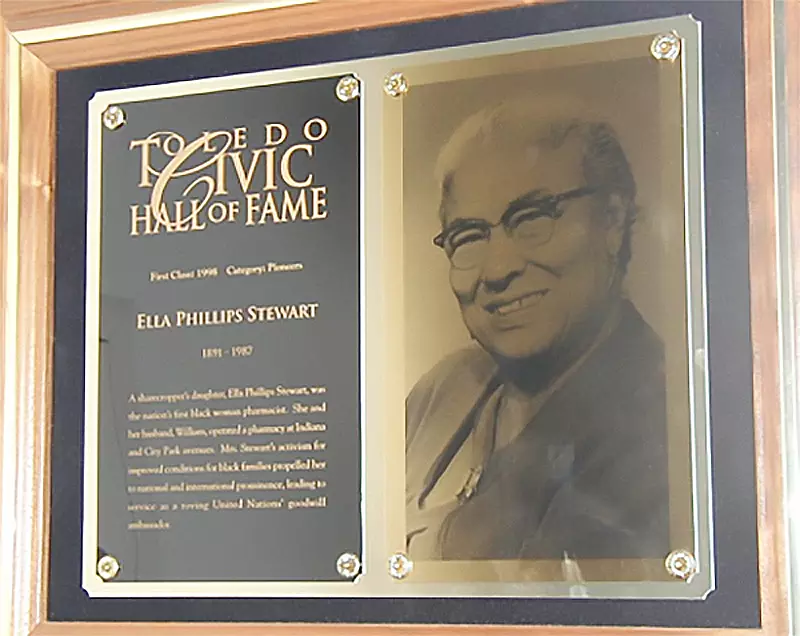Inductee biographies (1998-2004; arranged by year)
1998 Inductees
Florence Scott Libbey (1863-1938), volunteer
 Florence Scott Libbey (1863-1938)
Florence Scott Libbey (1863-1938)
The daughter of a successful Toledo real estate dealer, Florence was 27 years old and an avid art collector when she married Edward Drummond Libbey in 1990. Their only child was born in 1895 and died when she was nine months old. Florence and Edward donated enormous financial and leadership resources to the Toledo Museum of Art (TMA), including the Scott homestead and other Monroe Street property where the museum opened in 1912. The Libbeys resisted offers to name the museum after them. Florence outlived her husband by thirteen years. After Edward's death, she served as trustee and vice president of the TMA. During the Great Depression, she financed construction of the music wings of the Museum, including the Peristyle, thus employing some 3,000 persons. She died at her summer home in Pasadena, California, at 75 years old. Her estate was left to various interests, most notably the Toledo Museum of Art and a perpetual endowment to the Scott High School Library.
Ella Nora Phillips Stewart (1891-1987), volunteer
 Ella Nora Phillips Stewart (1891-1987)
Ella Nora Phillips Stewart (1891-1987)
Ella Stewart was the first female African-American pharmacist and a civil rights activist at local, national and international levels. Born in West Virginia to a sharecropper, she entered Stover College in Harper's Ferry at the age of twelve. She married a classmate, Charles Meyers, and moved to Pittsburgh. After their only child died of whopping cough, she became bookkeeper at a local pharmacy. Ignoring advice from friends, she pursued her new interest by applying to the University of Pittsburgh pharmacy program, where she was accepted after a year. She graduated with high marks, passed her state exam in 1916, and became the first practicing black women pharmacist in the country. She worked around Pittsburgh, Youngstown and Detroit for the next six years. During this time she divorced, and married another pharmacist, William "Doc" Stewart. They moved to Toledo to open its first black-owned and operated drugstore in July of 1922. Together, they ran Stewart's Pharmacy, at Indiana and City Park Avenues, until it closed in 1945. The living quarters above the store housed notable black visitors to Toledo who were refused rooms at local hotels, including Marian Anderson and W.E.B. Du Bois. Dispensing medicines and advice led Stewart to a wider role in community organizations. Locally, these included the Enterprise Charity Club, the Red Cross, the League of Women Voters, the Toledo Board of Community Relations, and the YWCA. She was elected in 1944 as President of the Ohio Association of Colored Women and in 1948 as President of the National Association of Colored Women. Her involvement at the international level included membership on the executive board of UNESCO. Despite her talents and accomplishments, she faced discrimination throughout her life. In 1957, her invitation to be honored as a "Distinguished Virginian" was rescinded by the Virginia Chamber of Commerce after it realized she was African-American. In response, a ceremonial dinner was held in her honor in Toledo on May 17. In 1961, Stewart Elementary School was named after her. Stewart moved to Pelham Manor in Toledo in 1980 and died at age 94 seven years later.
The Ella P. Stewart Collection, containing papers and scrapbooks, is located in the Canaday Center at the University of Toledo Libraries. Stewart School, in Toledo, houses a museum of her documents and artifacts.
John Elstner Gunckel (1846-1915), pioneer
Born in Germantown, Ohio and educated at Oberlin College, Gunckel moved to Toledo in 1875. Though starting out in real estate, he eventually became employed as a ticket agent for the Lakeshore and Michigan Southern Railroad. He was promoted to a traveling passenger agent and ended up representing the railroad for twenty years. Working as a ticket agent, Gunckel saw firsthand the life of deprivation and wasted potential lived by the city's mostly homeless "newsboys". The boys were generally disliked for their rowdy behavior and petty crimes. Gunckel invited 101 boys to a Christmas dinner in 1892, where, with help from local newspapers and businessmen, he helped them organize the Toledo's Newsboys' Association. Association rules forbade smoking, drinking, swearing and stealing. The association sponsored educational and social activities, and the formation of a popular Newsboys Marching Band. Gunckel founded the National Newsboys Association at the St Louis World's Fair in 1904. His 1905 book, Boyville, promoted newsboys associations and gained Gunckel national recognition. Gunckel led the efforts to build the Newsboys Building, which opened on Superior Street in 1911. Gunckel died at home in 1915, eleven years to the day after the National Newsboys Association was founded. The Toledo Newsboys Association was renamed the Toledo Boys Club in 1942. The club expanded to include girls in 1982 and was renamed the Boys and Girls Clubs of Toledo. Today the club serves 6,000 members with programs aimed at disadvantaged youth.
Edward Drummond Libbey (1854-1925), pioneer
Libbey was born in Chelsea, MA and attended Boston College. In 1883, he became owner of his deceased father's glass business. His search for cheaper fuel, materials, and labor led him to Toledo, where he moved the newly named Libbey Glass Company in 1888. Aided by the inventive ideas of Michael J. Owens, the company prospered. Libbey and Owens' innovations revolutionized the glass industry. Libbey founded many offshoot companies, culminating in a series of mergers that led to the Libbey-Owens-Ford Glass Company and Toledo's status as the "Glass City". Libbey's community involvement centered on the Toledo Museum of Art, which he helped establish in 1901. Together with his wife, Florence, Libbey contributed time, leadership, collections and money. Libbey High School, named in his honor, opened in 1923. Libbey died of pneumonia in November 1925. He and Florence are buried in Woodlawn Cemetery.
Paul Block Jr. (1912-1987)
Paul Block Jr. was born in New York City and graduated from Yale University in 1933. His father owned several newspapers around the country and purchased The Blade in 1926. Although he ran his papers from his New York office, he sent Paul and his brother, William, to Toledo to learn the business firsthand. The brothers were named co-publishers of The Blade in 1941 after their father's death. Although William remained on the masthead for decades, in reality he managed the Block's other newspaper, the Pittsburgh Post-Gazette, and Paul Jr. managed The Blade. Block's influence on Toledo was enormous. During Block's 46-year tenure, The Blade was known nationally for supporting causes years ahead of popular opinion, including civil rights, newspaper guilds, environmental causes, and opposition to the Vietnam War. Block published a series of articles which helped Toledo become one of the first cities to fluoridate its public drinking water. He launched the campaign to establish the Medical College of Ohio, and was its first board chairman. His efforts to revitalize downtown included chairing the Toledo Development Committee, whose leadership produced the SeaGate Center and Government Center, the city-county-state office building. Block's positions were not universally supported, as when he opposed UAW vice president Richard Gosser's efforts to establish a pension plan for all UAW plants in the 1950's. Block's first and real love was chemistry, having earned a PhD in organic chemistry at Columbia University and spending two years at Pittsburgh's Mellon institute in the early 1940's. While managing The Blade and promoting Toledo, Block published over twenty research reports, and held a faculty position at the University of Toledo. He maintained a research lab at his River Road home, and was perhaps the world's foremost authority on thyroid gland chemicals. He once observed that he was more comfortable working with chemicals than humans, because he always knew how chemicals would react.
Henry Morse (1907-1982)
Henry Morse is the only charter member of the Toledo Civic Hall of Fame who was born in Toledo. A highly successful banker (he retired as senior vice president and secretary of Toledo Trust in 1973); he enriched Toledo's civic life with numerous activities for over 50 years. Morse graduated from Scott High School and attended the University of Toledo. He began his banking career in high school as a messenger for the former Security Bank. His first community project began also in high school, when he helped organize the Toledo Amateur Basketball Federation in 1924. Morse was key in forming the parent organization of the Lucas County Recreation Center, and made arrangements to bring the Mud Hens back to Toledo in 1965. He served on the board of the Medical College of Ohio and led fund-raising efforts for the college. Other organizations served by Morse are the Toledo-Lucas County Safety Council, Toledo Orchestra Association, Clear Water (an environmental organization begun by Paul Block, Jr.), Greater Toledo Community Chest, and St. Luke's Hospital.
Jesup W. Scott (1799-1874)
Jesup Scott was born in Connecticut and trained to be a teacher and lawyer. In the 1820's, he moved to now Erie County to tend to his father-in-law's business. While publishing a small monthly newspaper, he began another paper, the Ohio Michigan Register and Emigrants' Guide. This paper is credited with encouraging settlement of the Maumee Valley area. In 1830, he founded the first area newspaper, in Perrysburg. In 1844 he moved to Toledo and became co-publisher of The Blade, the oldest continuing business in Toledo today. In 1872, Scott donated 160 acres of land to build a "Toledo University of Arts and Trades", now the University of Toledo. Scottwood Avenue and Scott High School are named in his honor.
John D. Anderson (1922-1986)
John Anderson was the son of Harold and Margaret Anderson, who founded the Anderson Elevator Company. He grew up in Maumee and attended Michigan State University. In World War II, he was a lieutenant in the Army Air Force. He became a general partner of the Andersons in 1946 and succeeded his father as senior partner in 1968. Anderson served on numerous boards and led various civic projects. At one time he was president of the Toledo Area Chamber of Commerce, the Toledo YMCA board, the United Way, the Toledo Board of Trade, the Community Chest, and the Toledo Rotary Club. He served on the boards of the Toledo Chapter of the Red Cross, the University of Toledo, Mary Manse College, St. John's High School and the Toledo Museum of Art. He also led fund-raising efforts for several local Catholic schools, and the Toledo United Appeal.
